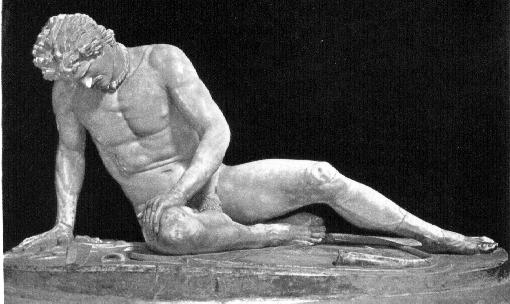 Photos courtesy of |
"Isabel saw no more of her attributive victim [Lord Warburton] for the next twenty-four hours, but on the second day after the visit to the opera she encountered him in the gallery of the Capitol, where he stood before the lion of the collection, the statue of the Dying Gladiator " (264). This is the picture of the Dying Gaul, often misidentified as the Dying Gladiator. For another view, go to the Dying Gaul/Dying Gladiator.. Since this statue is in the Capitoline Museum, it is probably the one referred to in Portrait of a Lady. For a picture of Pierre
Julien's
Dying Gladiator (1779), visit this
page at the Louvre
|
"The Dying Gaul" is the actual name, but the names have been used interchangeably throughout history.
"The Dying Gladiator" is actually a quite
popular literary reference.
Besides House of Mirth, you can find
it in all sorts of literary works by some very recognizable names:
- Wordsworth's poem, "Love Lies Bleeding" -- http://www.peart.com/bartleby/wordsworth/ww980.html
- Lord Byron's "Don Juan" -- http://www.ralphmag.org/don-juanX.html
- Hawthorne's "Marble Faun" -- http://www.bookrags.com/books/1faun/PART2.htm
- James's Portrait of a Lady --james7.html
- Dickens's Great Expectations - http://www.bibliomania.com/0/0/19/37/11476/5.html
http://www.louvre.fr/anglais/collec/sculp/rf4623/sculp_f.htm
The confusion over the names may have resulted from its use in popular literature.
Karen Reeves (English 462, Spring 2001) also points out that statues of the Dying Warrior from the west and east pediment of the Temple of Aphaia at Aegina are based on the same theme.